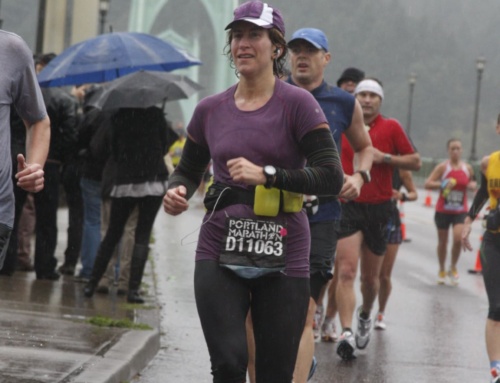As Boston-palooza continues—SBS’ race report will run on Wednesday—I’m briefly interrupt to speak on behalf of my lovely metronome, a plasticy, made-in-China, beepy thing that has become my go-to running gadget for the past 8 weeks. I have been running three times a week since I started running again in late February, and I haven’t left home yet without my ‘nome.
I guess that’s 25+ runs with it, so I’m no expert for sure, but I wanted to share a few things that have worked for me with it. Because it’s been a long day and I’m not capable of making fluid transitions with my sentences, I’m going to turn this into a Q+A, with me doing both the q’ing and the a’ing.
Q: What is a metronome?
A: You might know the tick-tock metronome from your piano days, as I do–I could never keep rhythm very well–and a running metronome is the same idea, only it clips onto your belt or can fit in the palm of your hand. You set it to beep every time one foot–either right or left–hits the ground. You can use a real metronome, as I do, and there are also metronome apps for smart phones, like this one for an iPhone.
Q: Why do I need a metronome?
A: You may not. I didn’t for about 20 years of my running, and then when I got all injured and out-of-whack, I turned to Chi Running, which promises to run injury-free for life. I have not seen that beautiful nirvana yet, but I will say that once you get past the dork factor of the ‘nome, it is an amazingly helpful tool.
A quick cadence–or small, plentiful steps–are key for staying injury free. You land lighter on your joints, you put less force on your muscles and you kind of get a circular motion going with your feet. (Running barefoot gets you to a similar point, because you don’t want to land as lightly as possible on those bare treads.) When I’m on the metronome, I think about my feet just tapping the earth and it rotate with every footfall. When I’m not, I overstride and land with such force, I could actually be stopping the earth. (Another Chi Running visual that I find really helpful: pretend like you have no lower legs when you run, so you’re “landing” on your knees. That brings your landing under your body and promotes a quick cadence as well.)
Q: What’s an ideal cadence?
A: The experts all say 90 steps per minute (SPM), which means hitting the ground with your left or right foot 90 times a minute. (Sometimes people will say 180, which just combines the two feet.) Taller people with crazy inseams get off the hook a bit, and can aim for a cadence of 85. I say, if you know you don’t have a quick one, just try to make it faster than what you have now.
Q: How do I get to that ideal cadence?
A: Glad you asked. Like most things in life–and all things in running–you have to start where you’re at and gradually build from there. No short cuts, unfortunately. Head out and run for five minutes without a ‘nome on, then start the beeping and adjust the metronome up and down until you get to the point where one foot is touching down as it beeps, but you haven’t changed your stride at all.
So you play with it a bit and realize your everyday, natural cadence is a 79. Spend a week running at a 79 just to get used to the rhythm; do all your regular workouts, but keep your cadence at a 79. (And it goes without saying: you have to commit to the ‘nome. Run with it as often as you can.) The following week, bump that bad boy up to 80. Ditto: get all your miles in at 80 steps per minute. Repeat until you get to the cadence that feels good to you; hopefully somewhere between 85 and 90.
That’s an ideal situation. Truth be told, it’s taken me longer than a week to get my cadence moved up a beat. I started at 81, then hung at 84 for about four weeks, and am finally at 85, but it feels hard. One more note here: it is really hard to go out and run at 85 or 90 when your body isn’t there. I tried on a long run last fall to just go at 86. I was quickly tired and frustrated and turned it off–and put it away.
Also, know that you have to go on solo runs and concentrate to get there. Kind of obvious, but I brought mine on a group run and tried to get the other interested ladies on the beat. It didn’t work very well.
Q: So does a quicker cadence mean I’ll go faster?
A: Not necessarily, but there is definitely the possibility that you’ll increase your MPH as you increase your SPM. I haven’t found that to be the case yet, but speed hasn’t been my priority. In Chi Running, they introduce four gears, which range from warm-up to speedwork. (Here’s a video that demonstrates them; check out the book for a much better explanation.) The key is this: no matter what speed you’re going, your cadence stays the same.
Little anecdote: Grant saw me running up the street after a four-miler. I asked him if he could tell if I was using the metronome. “You look like you’re really running and not just dragging, like you usually do,” he replied. I took it as a compliment.
Q: Isn’t the beeping annoying?
A: I was really concerned it would be. And when I was trying to go straight to 86 and skip the baby steps necessary to get to a higher cadence, it was. I resented the beep.
But now, I actually like it. When I’m in line with the beep, everything else seems to be going well: my posture is good; my focus is forward; my core is engaged; my legs are light. When I’m crossing a street or otherwise get distracted and am no longer coordinates with the beep, I feel like my body kind of caves and I revert back to old habits.
It’s obviously not music or an, ahem, entertaining podcast, but I am not missing either of them right now. I’m not missing my Garmin either. I’m good, just running to my own beep.
Have you run with a metronome? Have questions about it? We want to hear.








I tried the metronome app when I first started running, but I didn’t slowly build up to 90. I tried to start at 90 and convince myself it was my natural cadence. Needless to say, I stopped using the metronome. Now that I have been running for 6 months and have learned a little more patience after having to come back from an injury, I’m ready to let out my inner geek again. This time I’ll figure out my natural cadence and build up to 85 or 90. I’m looking forward to trying it later today. Thanks for posting this!
It sounds like it could be a helpful tool to someone using it. Although…. while running the Rock N Roll half-Marathon in March in DC, someone was apparently wearing one near me. I had no idea what it was at the time. I just kept hearing an incessant, rhythmic beat, but it wasn’t my rhythm. It DROVE. ME. NUTS!! I kept feeling like I had to run faster to get away from that annoying beeping. I must have made a potty stop, because I eventually lost the beeping around me. (If I had known it was helping someone, perhaps I would have had more patience with it.)
I haven’t tried one yet, but I am working on increasing my steps per minute. Getting a metronome is my next step, and I’m on the hunt for one. I tried downloading one on my phone, but carrying the phone on my runs doesn’t work for me.
from a music teacher – who never uses a metronome when playing music, a FAR easier way would be to run triplets, 3 steps per second, looking at your watch or the clock on the treadmill.
I do often run in triplets, setting it at 56 or 57 and waltz along. I don’t think I’d be coordinated enough to watch my watch and the road, but I like your thinking. And I love that you’re a music teacher. :)
I tried running with a metronome for the first time today. As a music teacher I thought, hey this should be easy, I use these things all the time! I hated it even after finding my cadence. I think that my cadence changes throughout my runs ever so slightly and I didn’t like the idea that I couldn’t change it at all. Maybe I ned to give it another go but honestly, I don’t think it’s for me.
I will be a member of your geek mother runner group too! I started running with my metronome app a few weeks ago when I do speedwork. This seems to be when I typically overstride and end up with a sore left quad/ITB. My natural cadence is 165 so I’ve been trying to do 176. After reading this – I think I’m trying too fast to start. I guess I should also try it with my regular running too instead of just speedwork. Thanks for the info! I would love for you to have the Dreyer’s on your podcast…just an idea :)
We’ve definitely thought about asking Danny, and probably will. Stay tuned, Holly, and go slowly. Gradual progress, as the Dreyers say. :)
As a musician, I too, went with the triplet feel…it was the easiest way to figure out how fast to go without using a metronome.
Yay Dimity :)!! I am a Chi Runner and a “metronome geek” too!! A few years ago I injured my I.T. Band and was sidelined from my running which was not good for me or my family. My husband, who is a Naturopathic Physician who specializes in Sports Medicine and structural/posture injuries (lucky me!), got me the Chi Running book to read and it changed my life. I was running tired, with the wrong posture, and kept getting injured. I read the book, watched the DVD’s, and then attended Danny Dreyer’s NYC workshops and have been a Chi Runner ever since. My injuries have subsided since I’ve been using my Chi Focuses. I used my metronome for my runs for the first year religiously. After a while, you get to know your cadence without using it. I use it now every couple of runs to keep me in check. I also have the Chi Running audio DVD’s on my IPod Nano so it gets mixed in with my music to bring me back to the correct form if I’m slacking!! Hopefully someday they will come out with a speed work workshop….I’ll be waiting! Someday I will get certified to spread the Chi Love in CT!
My question, too, is how it affects other runners nearby (especially in a race). My friend and I were racing this weekend, and it drove us crazy to have someone with one of those running right near us. I had purposely not worn my headphones so I could chat with my buddy, and instead we were driven crazy with the beeping (and wishing we had our headphones). That said, I could really see the benefits of using one, but I like my music too much. ;-)
Hey Cyndie: I hear you on that. I feel like when I keep it closed in my palm on the lowest volume, it’s not too bad, but I may be used to it. I am going to run one 10K with it to see what happens, but then may closet it for races.
Great timing! I went to a Newton running clinic and they guy told me I need to work on my cadence and told me about the clip on device. Cool!
Thanks for posting this! Like Erica, I just attended one of Newton’s Natural Form Running clinics (much like Chi Running) and it’s clear my cadence is something I need to increase. I’m just not sure I’m ready to part with my tunes – maybe after I get through this half marathon training cycle!
I’m with you! I don’t want to part with my music, it’s what keeps me going!
I ran next to a guy in a half marathon last summer who was using a metronome. Since I had read Chi Running, I was grateful that I could hear the beeping. It helped until we got separated, but having the cadence set in those early miles probably stayed with me through much of the race. As a side note, the runners on the other side of me were using Galloway walk breaks, so there was a lot of beeping all around.
Interesting concept. I have done something similar on runs, I do a count “1, 2, 3” or something like that sometimes. I seem to bust that out in my brain when I’m having a difficult patch in a run. My hubby (retired military) hates the cadences they used to do during PT runs, but he also says they were there for a reason :-) I like this idea of having a little beeper.
Thank you for the detailed explanation. I read about it in your book just last night. I guess I need to read Chi Running next.
Rather than use a metrononome, I record songs that get me to my ideal BPM. For example, Queen’s “We Wil Rock You” and the song “Juke Box Hero” and Rhianna’s “Rude Boy” are all (I believe – I’d need to check my play list) right around 170-180 bpm. Eminem’s “8 Mile” is 174 BPM and COld Play’s “Politik” is 172. If you cue these up on your ipod you can “practice” matching the speed of these songs. I have a play list that starts at 165PBM for my warm up, then gradually builds. It takes a while to get faster – months. There are web pages – try googling “running songs beats per minute” and you’ll get lists of songs at certain beats per minute. If I hear a song on the radio I like that “feels” like a good running tempo, I pull out my kids’ metronome and “clock” it to see if it’s right for me. Good luck – faster turnouver, shorter strides is THE BEST thing you can do for your body – less jarring, easier (I feel) to go longer distances once you get the hang of it (don’t get discouraged at first – it seems REALLY fast at first and you really do need to SLOWLY work your way up – that’s why I put some songs in that were slower – even those will feel REALLY fast at first – remember to take smaller steps!!!! Don’t throw your foot way out in front at that speed – it should fall RIGHT below your hip. :D
I also listen to Eminem’s ‘8 mile’….really good one to run to. :-)
I too am learning chi running and enjoy your posts of how your progress is going, Dimity. Used my metronome this morning. Felt I was waking the neighborhood house by house as I ran along! Tee hee! Please keep us all posted on your progress.
Thrilled that according to my Garmin foot pod, my cadence is between 86 and 90 every run. Is it ok to rely on the foot pod as an accurate reflection of your SPM.?
Surely, Heather. If you don’t mind my saying so, nice cadence!
As a novice runner, I still need my music when I run, to keep me going. I’ve been looking into apps that will either play music with a given BPM, or will adjust my music to the BPM that I want (I think the one I’m thinking about getting is Music Runner). Has anybody tried one of these apps? I also like the idea that I can play it through my headset, and not bother others. :)
There is an app on iPhone called PodRunner. They have a lot of hour long podcasts that play at different beats. The original PodRunner is free and there is an upgrade that costs money (not sure how much).
My problem is that I have no rhythm. No idea how to get my feet co-ordinated with the beat. I would love any suggestions you have!
There isn’t really a scientific way I use, Jacqui: sorry. When I fall off, I just concentrate on putting one foot down with the beep, and if I’m not on the rhythm for the second beat, I speed up my cadence (shorten my stride) and try again. Really just hit and miss for me, but there may be a better way.
I definitely need to work on my cadence, it is typically around 165 at the mo, I have also found certain songs are better to run to for speeding up but the thought of having to listen to those couple songs over and over….and over….and…..over……….zzzzzzzzzzz
The metronome thing looks like it may b e worth a try, I can be pretty anal so it may work….then again I DO like listening to my music, I may just need to find more songs which help me get to the correct cadence for me….
I have always loved running too “Ain’t goin down till the sun comes up”. Always felt like it had the perfect beat to keep me on a good pace – just checked and I think it’s about 86-90 spm! However, I always feel like its a bit of a pushing-it pace for me. Have to play around and see if I can learn to keep the same cadence at a slower pace. I generally try to think about keeping my feet under my hips instead of out in front, and find that automatically speeds my cadence somewhat.
And give up AMR podcasts!
I so wanna try this though. I long for running “light”. I wonder if it might help quiet the mind too? like a form of meditating. Or if the beeping would get irritating? Anyways, Chi running is my next book after TLAM :)
I tried a metronome for the first time today. A couple of things were different. First, I’m used to my shuffle which is tiny and clips on to my waistband. Instead of that I brought my iPhone with me that I put in my amphipod. I don’t really like the amphipod because it doesn’t stay put. That was the first issue. I thought, being a musician and music teacher that the metronome would be really good for me. I figured out my cadence and had it going (88 for me!) and then I was off. After 10 minutes the beeping in my headphones was driving me crazy. So, I put some music on in the background just to have something else going. It was quiet enough that I could focus on the beeps but loud enough that there was something else to listen to. That only lasted another 10 minutes. After that, I had to turn the beeping off. It was driving me crazy. I do feel like the rest of my run was better because I had more consistent cadence, however I think that my cadence changes as I run. Part of the reason for that is that my cadence changes with my music but sometimes I just like to slow down or speed up a bit. Is that bad? Looking for any suggestions. Thanks!
Hi Dimity,
I just bought a metronome, and was about to use it when I found out that I have a tibial stress fracture :(
Anyway, while I am healing, I am reading Chi Running. I was wondering if you got personal training on the method, or did you just read the book, watch the DVD’s, and figure it out for yourself. I’m having a hard time how this is going to work for me. Do you think it’s worth going to a $250 workshop with a Chi Running instructor?
I rarely leave responses, however i did some
searching and wound up here Tell Me Tuesday: How To Run With a Metronome
I haven’t read chi running but I did once do a workshop with the author where I discovered 180 BPM thing.
I set my metronome to 60 BPM and do 3 steps per beep. I’m a drummer so I like this kind of thing. I also sync my breathing to this tempo using different rhythms but generally in time with the beep. It gives me great focus and resolve. I don’t listen to music though because of this. Various tempos are very distracting. Podcasts if anything.
I use COUNTU Tempo as my running/swimming metronome. It’s smaller and cheaper, with lap counter and timer function.